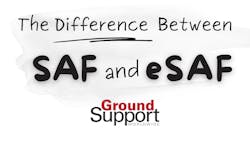
As a drop-in replacement for Jet A fuel, sustainable aviation fuel (SAF) is playing an important role in decarbonizing the aviation industry.
But how SAF is produced varies based on feedstock and refining processes, explains Pratik Chandhoke, senior manager technical services, renewable aviation, Neste.
“Neste uses [hydrotreated esters and fatty acids] HEFA technology, and we use waste oils and greases for our feedstock and hydro-process it,” he says. “But SAF can be made eight different ways.
Among the eight pathways in compliance with the ASTM D7566 specification is the Fischer-Tropsch (FT) pathway.
eSAF, which can also be referred to as power-to-liquid and abbreviated P2L or PTL, uses the FT pathway. According to officials at Twelve – a producer of eSAF, the process converts renewable electricity, water and CO2 into synthetic liquid fuels that can be used in aviation.
The CO2 can be captured from various sources, such as industrial emissions, biogenic waste or direct air capture while the renewable electricity can be generated from solar, wind, hydro or other sources, officials at Twelve explain.
“At the end, the product is all hydrocarbon,” explains Chandhoke. “What you’re trying to do is take these waste oils, or CO2 or municipal solid waste or plastics – whatever you have for a feedstock – you’re trying to get to a point where you are making the hydrocarbons that are similar to jet fuel.
“The difference is processes and feedstocks. The process to make PTL is different than HEFA.”
While the process vary between HEFA, FT and other pathways like alcohol to jet (AtJ), the outcome of creating hydrocarbons is similar. This creates advantages for SAF because it can be blended into conventional jet fuel.
“Everything is the same at the end. There might be differences in how well the properties meet,” Chandhoke says. “But at the end, it’s similar hydrocarbons that we’re trying to make.”
More on Sustainable Aviation Fuel (SAF)
AviationPros Source eBook: Sustainable Aviation Fuel (SAF)
What is SAF?
AviationPros Podcast: Sustainable Aviation Fuel 101
About the Author
Josh Smith
Editor
Josh Smith served as editor of Ground Support Worldwide as editor from 2016 through 2024. He oversaw production of the print magazine, created GSW's newsletters on a daily basis, and updated the latest news on AviationPros.com.
